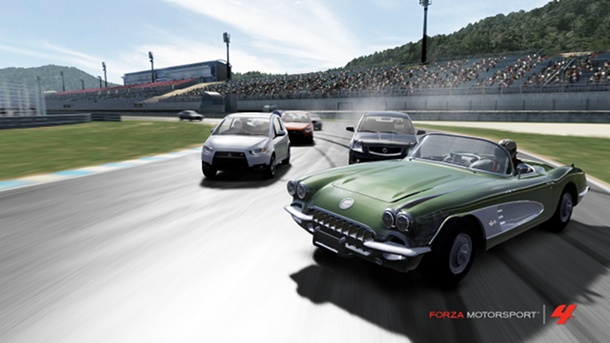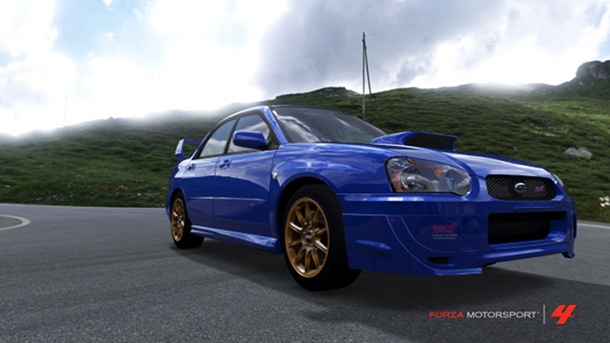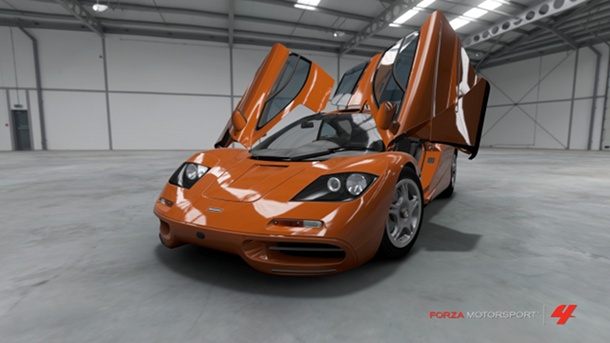
We’ve got a problem: Forza Motorsport 4 is being labeled as a simulation game. Don’t get me wrong; it can be that, and it does an extremely good job. The issue here is that the term simulation is very off putting. It screams inaccessibility and implies a steep learning curve only to be tackled by the most hardcore gamers and racing enthusiasts. From the time I spent with Forza 4, however, I can tell you that nothing is further from the truth. The folks at Turn 10 have created a hardcore simulation racing game, that’s true, but then they covered it with layer upon layer of accessibility and positive user experiences. Not only that, but they’ve turned it into a virtual space for not only fans of cars and racing games, but for artists, tuners, and entrepreneurs as well! I think that it would be much more fitting to refer to Forza 4 as a driving experience.
How have they done that? By creating a ridiculously customizable racing engine that caters to the player. This isn’t something entirely new; they’ve been crafting this system over the last four games, but in Forza 4 they finally nailed it. Before starting a race, players have access to a large number of assists that can be toggled, anything from turning off traction control to having the game brake for you. What this means is that we can play the game as a simulation or as an arcade racer. The choice is really up to us. Of course, turning off assists nets more winnings, so you’re always encouraged to challenge yourself.

The game gives you plenty of ways to do that. Career mode has been revamped yet again, with each season taking you along a set path between locations. The difference is that while in Forza 3 we were encouraged to try a new car or a new track with each event, here the events at each location change depending on what car we’re currently driving. This is a welcome change as it gives us more freedom to drive the cars we want. Let’s be honest, having 500 cars in the game doesn’t mean we want to drive them all. It means that it’s more likely they’ll have our favorite Subaru Impreza WRX STi. If the car we want to drive is in a lower class than the event we selected, Forza will find the optimum upgrades to make it competitive. If we’d rather upgrade it ourselves, we can do that. In this way progression never feels like a chore, but instead enjoyable.
Working through career mode isn’t the only way to progress; it’s far from it! Much like the previous games, each event nets us experience that goes towards our driver level and manufacturer affinity, both of which are handled differently this time around. For instance, when our driver level goes up, we’re presented with a choice of multiple cars as a reward instead of just one, all of which are connected by some sort of central theme. This makes every time that we level up considerably more exciting as it increases the chance we’ll actually care about our reward. Manufacturer affinity completely replaces car levels and it makes so much more sense. In previous iterations, individual cars would level up as we used them, netting us discounts on upgrades from that manufacturer. In Forza 4, however, manufacturers share levels among all of their cars. This does a much better job of giving us the sense that we’re always progressing and that something new is just around the corner.
Outside of the career, there are a number of other modes to explore. New to the series is rivals mode. In it, we pit ourselves against other players’ times/scores in a series of events, and it’s excellent. Over the past few days I barely saw anything else in the game due to being locked in an epic quest for glory against a friend of mine. He’d post a time, I would beat the time, he would switch cars and beat my time, I’d notice his lap was dirty (he either left the track or hit something) and I’d race a slower lap but clean. It’s full of this back and forth play between players. When we beat one rival, the game suggests another rival to beat. The whole time we’re doing this we’re also earning credits and experience points. Brilliant.

And then there’s Autovista mode. Wow. We’re given a small number of cars and allowed to explore them as much as we want. This was pitched originally as a feature built for Kinect, but a controller works just fine. We can open doors, get inside, and even look at details on the engine and interior. Both outside and in the car there are key points that we can select to learn more, including one for each car narrated buy Top Gear’s Jeremy Clarkson. Admittedly, it’s little more than a diversion and won’t hold our attention for very long due to the small number of cars available, but it’s extremely detailed and a great way for the developers to show off.
If it sounds like we’re gushing over the latest Forza game, it’s because we are. But, it completely deserves it. Turn 10 has gone out of its way to make sure the game isn’t shoehorned into a niche that not many gamers can enjoy. It’s not enough for a game to be a simulator. It needs to capture what makes cars cool. Forza 4 has finally done it.
This review is based on a copy of the game purchased by the reviewer.

1 Comment